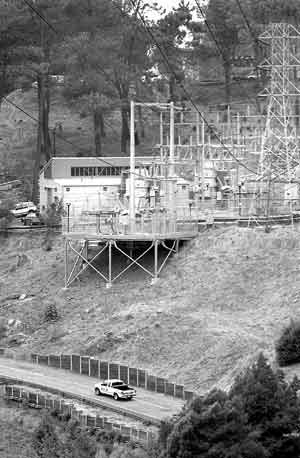|
HOME | SEARCH | ARCHIVE |
|
Let there be light
New substation limits chance of campus power outage
![]()
By D. Lyn Hunter, Public Affairs
| |
|
27 SEPTEMBER 00 | On May 19, 1998 - a date much remembered - the campus suffered a massive power outage, putting classrooms, labs and offices in the dark from noon until 5 p.m.
Exams were cancelled, research was destroyed, data was lost and hundreds of staff were unable to do their work. The outage contributed to more than $500,000 in physical damage and lost productivity.
The incident began when campus engineers discovered a 1,000-pound copper pipe - charged with 12,000 volts of electricity - sagging dangerously close to another one at the Grizzly Peak electrical substation. To avoid a catastrophic explosion, power was immediately transferred to a co-generation plant. When the privately operated co-generation plant failed to supply power, the campus went dark.
But the campus need never worry about this kind of outage again, thanks to the construction of a new substation on the hill above campus.
"The structural problem that caused the 1998 outage won't happen with the new Hill Area Substation," said Robert Newell, campus utilities manager. "The most modern equipment and designs were used, making it more reliable and safe."
For more than 40 years, the old Grizzly Peak substation was the campus workhorse, and served Lawrence Berkeley National Lab as well. But it had only one feeder line to campus; if that feeder went down, as it did two years ago, the university lost all power.
The new station began powering the campus Aug. 21; it will have two feeder lines - either of which can serve the campus alone if necessary - by the middle of next year. One line will feed to Switch Station Five, located near Cory Hall, and the other to Switch Station One, near Barrows.
The Hill Area Substation, which has three times the power of the old station, features a state-of-the-art computerized control system, said Albert Olds, a Berkeley electrical engineer.
The Supervisory Control and Data Acquisition system, in conjunction with other protective technology, will digitally monitor the campus power supply - such as currents, voltage and temperature, he said. The computer technology also allows for better recording and analysis of incidents that do occur, such as circuit breaker openings.
Another innovation is the enclosure of much of the station's equipment. All the 12,000-volt circuitry, which requires the most maintenance, is now housed, keeping it safe from the elements and making it easier to work on. Newell said his electricians received special training to work on the equipment at the new substation.
Seismic upgrades were made as well. The new feeder lines are enclosed in a concrete duct for most of their journey down the hill to the campus. Where they cross the Hayward fault, they run through a special armored casing laid in a sand-filled trench - making them more flexible and less prone to breakage in the event of an earthquake.
Problems with the co-generation plant have also been corrected, Newell said. "After the failure two years ago, we immediately set out to remedy the situation. The system has been tested numerous times and is working beautifully. It won't happen again."
The Hill Area Substation was paid for with savings that Physical Plant accrued after purchasing the Grizzly Peak station from PG&E in 1995. With reduced electrical rates, the campus saved nearly $3 million dollars per year, which financed the construction of the new station.
"The activation of this new electrical substation represents a major leap forward in the reliability of the campus energy system," said Johnny Torrez, director of physical plant. "The old Grizzly station served us well for many years, but it was unable to support the increased computer and research demands of the campus. With this new station, we not only have brand new equipment and advanced technology, we also have enough capacity to last us far into the future."
Home | Search | Archive | About | Contact | More News
Copyright 2000, The Regents of the University of California.
Produced and maintained by the Office of Public Affairs at UC Berkeley.
Comments? E-mail berkeleyan@pa.urel.berkeley.edu.
